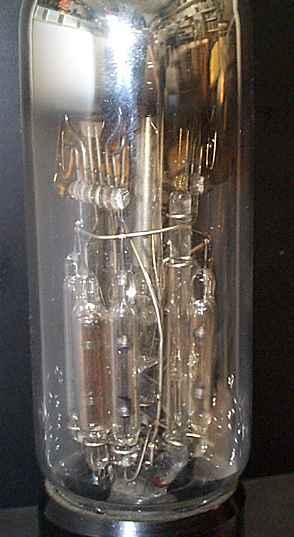
 Loewe 3NF Multi-valve - The first
integrated circuit.
Loewe 3NF Multi-valve - The first
integrated circuit.
One of the most fascinating valves you will ever see, the Loewe 3NF incorporates three triodes, two capacitors and four resistors in a single glass envelope. The inclusion of the passive components reduced the number of pins required to six, but to avoid them contaminating the vacuum, they are each sealed inside a glass tube.
One of the reasons for the development of this amazing device was that in Germany, there was a tax on receivers based on the number of valves in the set, so in 1926, Loewe Radio A.G introduced the 3NF, and also another multi-valve, the 2HF, which contained two screen-grid tetrodes, two resistors and a capacitor, intended for use as a two-stage RF amplifier. The original Loewe multi-valves are masterpieces of glasswork, which must have been very expensive to manufacture, so later versions used a mica supports, and the glass was given an aluminium outer coating to hide the less elegant internal structure. An obvious drawback of putting three valves in a single envelope is that if one filament fails, the whole device becomes useless, but to counter this disadvantage, Loewe offered a repair service to replace failed filaments.
Loewe later developed a more sophisticated multi-valve, the WG36, which was enclosed in a metal shield, containing two variable-mu pentodes and a triode, used respectively as RF amplifier, IF Amplifier, and oscillator.
My 3NF with holder, close-up showing passive components, and the anode cylinder of the central vertical triode.


(Left) Close-up showing the two horizontal triodes, with the spiral wire grids just visible inside. (Right) later 1929 mica-support version of 3NF, with outer coating partially removed, in the London Science Museum.


Loewe OE333 radio, Deutsches Museum, Munich.

Base diagrams - 2HF, 3NF, WG38



Circuit diagram of radio using 3NF , Glass encapsulated capacitor and
resistors as used in 3NF


Original advertisment.


Another multi-valve type device, containing a photocell and amplifier in the same envelope.
